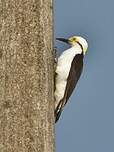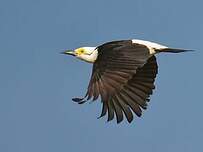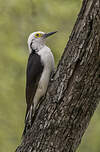White Woodpecker
Melanerpes candidus - Pic dominicain
Identification
The White Woodpecker is a small to medium-sized bird easily recognizable by its white to creamy-white head, throat and bellly. The lower belly is yellowish. The pale and gray eye is widely circled with bright yellow. A thin black band extends from the back of the eye to the glossy black mantle. The male has a yellowish spot on the back of the neck. The beak is of medium size, straight, its color ranging from gray to black, being more light at its base. The back and top of the tail are white. The tip of the tail is black with some white spots. The tip of the wings is brownish. The legs are dark gray. The female has no yellow marking on the neck and belly. The juveniles are more brown than black.
Subspecific information monotypic species
Foreign names
- Pic dominicain,
- Carpintero blanco,
- pica-pau-branco,
- Weißspecht,
- fehér küllő,
- Witte Specht,
- Picchio bianco,
- vitspett,
- Hvitspett,
- tesárik biely,
- datel běloprsý,
- Hvid Spætte,
- valkotikka,
- picot blanc,
- dzięciur biały,
- Белый дятел,
- シロキツツキ,
- 白啄木鸟,
- vitspett,
- 白啄木,
Voice song and call
Habitat
Behaviour character trait
Little is known about the habits of this bird: no nest has ever been observed. It seems to nest in holes in trees, but it also takes advantage of holes in rocks. It is often seen in groups of 5 to 10 individuals, sometimes with other White Woodpecker. These gatherings probably have a defensive purpose against predators. The breeding period is usually from September to November. The female lays 3 to 4 eggs that are incubated by both parents. The fledglings take off at 36 days.
Flight
Dietfeeding habits
Geographic range
Threats - protection
IUCN conservation status
concern
in the Wild
threatened
evaluated
Although there is not precise data, the White Woodpecker does not seem to be in danger: it is probably quite common. Its habit of consuming fruits in plantations often leads to conflict with humans and unfortunately it is sometimes even poached in Argentina.
Sources of information
- IOC World Bird List (v15.1), Gill, F and D Donsker (Eds). 2025-12-07.
- Avibase, Lepage Denis
- Arthur Grosset's Birds, Arthur Grosset
- Vol. 7 - Handbook of the Birds of the World, Josep del Hoyo-Andrew Elliott-Jordi Sargatal
- Wikipédia, Wikipedia, The Free Encyclopedia
- A Field Guide to the Birds of Brazil, Ber Van Perlo
- Birds of Peru, Thomas S.Schulenberg, Douglas F.Stotz, Daniel F.Lane, John P.O'Neill, Theodore A.Parker III
Other sources of interest
 Specification sheet created on
02/08/2023 by Anne et Gabriel Leboff
Specification sheet created on
02/08/2023 by Anne et Gabriel LeboffTranslation by AI Oiseaux.net
© 1996-2025 Oiseaux.net
- Accipitriformes
- Aegotheliformes
- Anseriformes
- Apodiformes
- Apterygiformes
- Bucerotiformes
- Caprimulgiformes
- Cariamiformes
- Casuariiformes
- Charadriiformes
- Ciconiiformes
- Coliiformes
- Columbiformes
- Coraciiformes
- Cuculiformes
- Eurypygiformes
- Falconiformes
- Galliformes
- Gaviiformes
- Gruiformes
- Leptosomiformes
- Mesitornithiformes
- Musophagiformes
- Nyctibiiformes
- Opisthocomiformes
- Otidiformes
- Passeriformes
- Pelecaniformes
- Phaethontiformes
- Phoenicopteriformes
- Piciformes
- Podargiformes
- Podicipediformes
- Procellariiformes
- Psittaciformes
- Pterocliformes
- Rheiformes
- Sphenisciformes
- Steatornithiformes
- Strigiformes
- Struthioniformes
- Suliformes
- Tinamiformes
- Trogoniformes




























